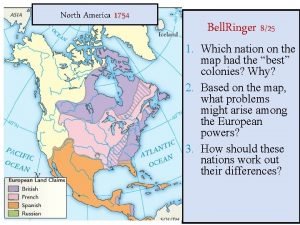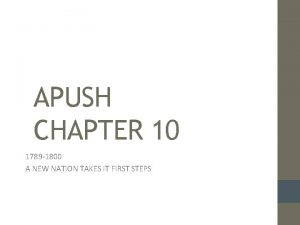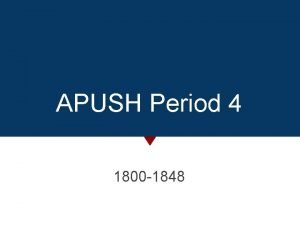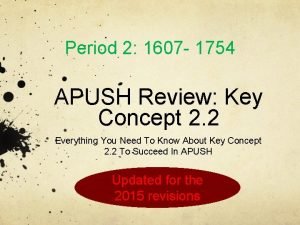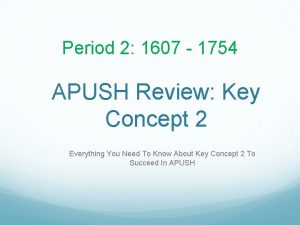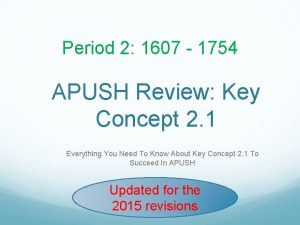Period 3 1754 1800 APUSH Review Key Concept









- Slides: 9

Period 3: 1754 – 1800 APUSH Review: Key { Concept 3. 1 Everything You Need To Know About Key Concept 3. 1 To Succeed In APUSH

The New Curriculum Key Concept 3. 1 “Britain’s victory over France in the imperial struggle for North America led to new conflicts among the British government, the North American colonists, and American Indians, culminating in the creation of a new nation, the United States. ” Page 32 of the Curriculum Framework Big ideas: How did Native Americans’ relationship with the colonists change after the 7 Years War? What led to Britain ending salutary neglect? Why and how did colonists resist this? What were the US’ foreign policy goals post-independence?

Key Concept 3. 1, I “‘Throughout the second half of the 18 th century, various American Indian groups repeatedly evaluated and adjusted their alliances with Europeans, other tribes, and the new United States government. ” - Page 32 of the Curriculum Framework As the English colonists expanded into the interior (Ohio River Valley, ) conflicts emerged French and Indian War (7 Years War) – Britain and colonists versus the French and Natives Iroquois allied with the British Native life changed drastically after the war The French were removed from North America – lost a trading partner British colonists expanded on to native land Pontiac’s Rebellion -> Proclamation Line of 1763

Key Concept 3. 1, I Cont. During the Revolutionary War, some natives sided with the British: 3 of the 6 Iroquois Confederacy supported the British The Oneida and Tuscarora sided with the Americans Years after the war (1795), natives ceded land under the Treaty of Greenville In return, natives received an acknowledgement of their claim to certain territory

Key Concept 3. 1, II “During and after the imperial struggles of the mid-18 th century, new pressures began to unite the British colonies against perceived and real constraints on their economic activities and political rights, sparking a colonial independence movement and war with Britain. ” - Page 33 of the Curriculum Framework Debt from the 7 Years’ War helped lead to the end of Salutary Neglect: Britain tightened its control over markets, taxes, and colonial government – many colonists resisted this new policy Stamp Act Congress (1765) – colonial response to Stamp Act, tarred and feathered tax collectors; Stamp Act was repealed Committees of Correspondence (1770 s) – spreading of info and propaganda about British policies Intolerable Acts (1774) – passed in response to the Boston Tea Party; shut down the port of Boston until damages were paid

Key Concept 3. 1, II Cont. Individuals involved in the independence movement: Elites: Paul Revere and John Hancock – wealthy merchants that protested taxation Grassroots movements: , Mercy Otis Warren – writer that urged independence Arguments for independence: Rights of British subjects: Rights of individuals: Taxation, writs of assistance, admirality courts Enlightenment ideas: Rejection of “virtual representation” – idea that Parliament acted in best interest of all British subjects Consent of the governed “Life, liberty, and property” How did colonists win? Familiarity with the land, military leadership (Washington, Arnold), deep commitment to their cause, and foreign aid – most notably the French, after Saratoga

Key Concept 3. 1, III “In Response to domestic and international tensions, the new United States debated and formulated foreign policy initiatives and asserted an international presence. ” - Page 33 of the Curriculum Framework After the Revolutionary War, European countries still posed challenges to the US America remained neutral in war between British and French following the French Revolution British seized American ships trading with French England still had a strong presence in North America, and even America Did not abandon some posts (forts), such as Fort Niagara, as promised in the Treaty of Paris of 1783

Key Concept 3. 1, IIIBeware Cont. of foreign French. Viva Revolution La alliances and political parties Influenced by American Revolution and Enlightenment ideas France! US remained neutral in conflict between France and Britain Washington’s Farewell Address: Warned of permanent alliances and dangers of political parties After Washington’s presidency, conflict between Britain and France helped lead to partisan debates in the 1790 s Democratic-Republicans (Jeffersonians) tended to support the French Federalists (led by Hamilton) tended to support the British

Test Tips Multiple-Choice and Short Answer Questions: Wars and their impacts on Native Americans (7 Years and Revolutionary Wars) Washington’s Farewell Address Impact of the 7 Years War (End of salutary neglect) Challenges faced post-independence Essay Questions: Political, social, and economic causes of the Revolutionary War How can the French And Indian War be seen as a turning point in American History?

